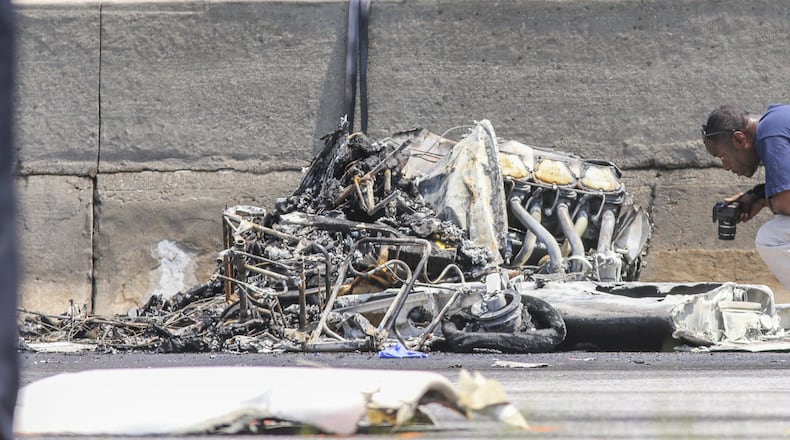The plane crash that killed all four people aboard and halted traffic on I-285 for hours "could have happened to anybody," an investigator with the National Transportation Safety Board said Tuesday.
In its final report on the May 2015 crash that killed pilot Greg Byrd, his sons Christopher and Phillip, and Christopher’s fiancée, Jackie Kulzer, the NTSB cited a partial loss of engine power due to a contaminated fuel manifold as the likely cause.
The Byrds and Kulzer were en route to Oxford, Miss., to attend Greg Byrd's youngest son's graduation. They made it just 2 miles after taking off from DeKalb-Peachtree Airport, crashing onto a median wall on the interstate. Miraculously, no one on the ground was injured.
“Post-accident testing of the fuel manifold showed that it was not operating normally and was contaminated with debris,” the NTSB report states. “The composition of debris and its origin could not be determined, but it was likely that the debris moved within the fuel manifold during operation and resulted in fluctuating power indications.”
One witness told NTSB investigators the engine sounded like it was at “wide open throttle” before it crashed, exploding into flames. Another witness, watching from beyond the departure end of the runway, said the plane was moving slowly and was only “75 to 100 feet” above ground when it went over his head.
While investigators reported Byrd had concerns before his final take-off, they do not believe pilot error was a factor in the crash.
“I don’t believe that it was the pilot’s fault,” NTSB lead investigator Eric Alleyne told Channel 2 Action News. “I think he did a good job trying to maneuver the airplane the way he did. It’s just unfortunate that it ended up in an accident and lives were lost.”
Four days before the crash, Byrd barely cleared a thicket of trees at the end of the DeKalb-Peachtree Airport runway. His mechanic estimated only 50 feet separated Byrd’s single-engine aircraft from the trees, according to the NTSB.
The following day, Byrd texted his mechanic that he conducted a test flight, and while “the run-up was good … he wasn’t getting full rpm at full power while static,” the NTSB found. Thirty minutes later, the pilot called the mechanic and told him he had flown the airplane and “everything was normal.”
Although the airplane was likely loaded 24 pounds in excess of its maximum gross weight, Alleyne said he didn’t think it was a significant issue.
“That doesn’t mean as soon as you hit that maximum gross weight, you know, that the plane is just uncontrollable or what have you,” the investigator told Channel 2.
About the Author


